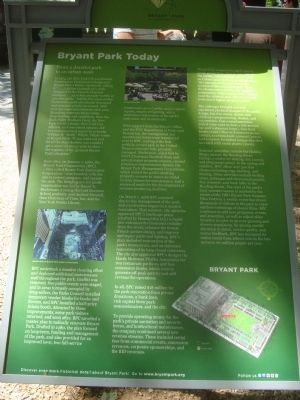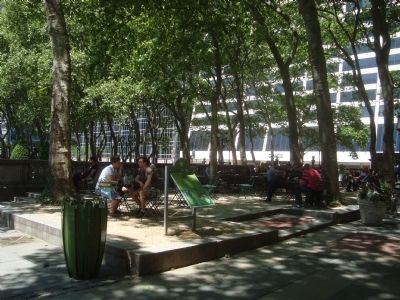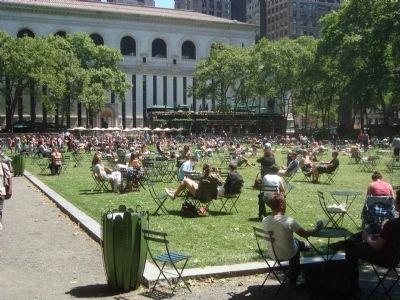Midtown South in Manhattan in New York County, New York — The American Northeast (Mid-Atlantic)
Bryant Park Today
From a derelict park to an urban oasis
Inscription.
In 1974, the New York Landmarks Preservation Commission designated Bryant Park a Scenic Landmark, call it “...a prime example of a park designed in the French Classical tradition...an urban amenity worthy of our civic pride.: Within five years of this declaration, park attendance decreased and criminal activity increased, with over 150 reported robberies each year. Mounting concern about crime, drug-trading, and vandalism, from the Rockefeller Brothers Fund, the New York Public Library, New York City officials, and concerned citizens, led to a commissioned report by urbanist William H. “Holly” Whyte. Whyte wrote of Bryant Park: “If you went out and hired the dope dealers, you couldn’t get a more villainous crew to show the urgency of the [present Bryant Park] situation.”
Soon after, on January 1, 1980, the Bryant Park Corporation (BPC) – then called Bryant Park Restoration Corporation – was founded, with the aim to restore, program, and operate the park. The fledgling not-for-profit organization was led by Daniel A. Berderman, a young Harvard Business School graduate, and Andrew Heiskell, the Chairman of Time, Inc. and the New York Public Library.
BPC undertook a massive cleaning effort and deployed additional maintenance staff throughout the park. Graffiti was removed, free public events were staged, and in areas formerly occupied by drug-sellers, the Parks Council installed temporary vendor kiosks for books and flowers, and BPC installed a half-price tickets booth. Attracted by these improvements, some park visitors returned, and soon after BPC unveiled a master plan to radically renovate Bryant Park. Drafted in 1980, the plan focused on long-term, funding and management of the park, and also provided for an improved lawn, two full-service restaurants, gravel paths, major capital repairs, improved lighting, and a meticulous restoration of the park’s restrooms and monuments.
With support from the Mayor’s Office and the NYC Department of Parks and Recreation, the management and operational duties were transferred over to the BPC, making it the first publicly-owned park in the United States to become fully privately managed. Bierderman, aided first by NYPL Chairman and several major property-owners, created a business improvement district, the Bryant Park Management Corporation, which united the park’s abutting property-owners to assure an initial income stream for maintenance, and a source of credit for the development of revenue-producing facilities.
On March 1, 1988 BPC assumed day-to-day management of the park, and construction began on a massive renovation. That summer, city agencies approved BPC’s landscape plans (drafted by Hanna/Olin Ltd.) to build new entrances for increased visibility from the street, enhance the formal French garden design, and improve and repair paths and lighting. BPC’s plan included restoration of the park’s monuments, and an elaborate renovation of its long-closed restrooms. The city also approved BPC’s designs (by Hardy Holzman Pfeiffer Associates) for two restaurant pavilions and four concession kiosks, which were to generate off-peak activity and add revenue for operations.
In all, BPC raised $18 million for the park renovation from private donations, a bank loan, risk capital from park concessionaires, and the city. To provide operating money for the park’s private sanitation and security forces, and horticultural maintenance, the company combined several new revenue streams. These included rental fees from commercial events, concession revenues, corporate sponsorships, and BID revenues.
Bryant Park reopened in April 1992 to lavish praise from citizens and visitors, the media, and urbanists. As noted in an Urban Land Institute award citation, “the success of the park feeds the success of the neighborhood.” Soon the chorus was joined by the business community, whose assessments helped fund the renewal, and who now benefit from much higher property values.
The redesign brought not only significant physical changes in the parks design, but free music, dance, and children’s programming, classes, and concessions. Year-around amenities added since 1992 including a full-service bar and restaurant (1995), four food kiosks (1992), free wi-fi internet access (2002), a custom-built carousel (2002), and a custom furnished lounge-like deck accented with exotic plants (2009). Seasonal amenities include the Holiday Shops (2002), the Reading Room (2003), a winter ice skating rink (2005), and ping pong (2009). In the spring and summer, BPC offers over 500 free classes including yoga, knitting, and fencing. Other activities include birding tours, petanque and chess tournaments, free concerts, and book talks in the Reading Room. The start of the park’s busy summer season is marked by the return of the HBO Bryant Park Summer Film Festival, a weekly event that draws thousands of visitors to the park to enjoy outdoor screenings of classic films. BPC continues to add new programs, events, and amenities, as well as adjust older favorites to cater to an ever-growing and diverse population. By paying careful attention to detail, service quality, and visitor feedback, BPC has increased its visitor count from almost zero in the late 1970s to six million people per year. Discover even more historical detail about Bryant Park! Go to www.bryantpark.org
Topics. This historical marker is listed in these topic lists: Architecture • Parks & Recreational Areas. A significant historical month for this entry is January 1913.
Location. 40° 45.222′ N, 73° 58.97′ W. Marker is in Manhattan, New York, in New York County. It is in Midtown South. Marker can be reached from West 40th Street. This marker is located in Bryant Park which is bounded by West 42nd Street, 6th Avenue (Avenue of the Americas), West 40th Street and the New York Public Library. Touch for map. Marker is in this post office area: New York NY 10018, United States of America. Touch for directions.
Other nearby markers. At least 8 other markers are within walking distance of this marker. Welcome to Bryant Park (a few steps from this marker); Monuments in Bryant Park (within shouting distance of this marker); a different marker also named Welcome to Bryant Park (within shouting distance of this marker); Buildings Overlooking Bryant Park (within shouting distance of this marker); a different marker also named Welcome to Bryant Park (within shouting distance of this marker); Reservoir Square (within shouting distance of this marker); Marvin Sylvor (about 300 feet away, measured in a direct line); a different marker also named Welcome to Bryant Park (about 300 feet away). Touch for a list and map of all markers in Manhattan.
Also see . . . Bryant Park History. Park website entry (Submitted on July 3, 2012, by Barry Swackhamer of Brentwood, California.)
Additional keywords. Landscape architecture
Credits. This page was last revised on July 14, 2023. It was originally submitted on July 3, 2012, by Barry Swackhamer of Brentwood, California. This page has been viewed 466 times since then and 16 times this year. Photos: 1, 2, 3. submitted on July 3, 2012, by Barry Swackhamer of Brentwood, California. • Bill Pfingsten was the editor who published this page.


